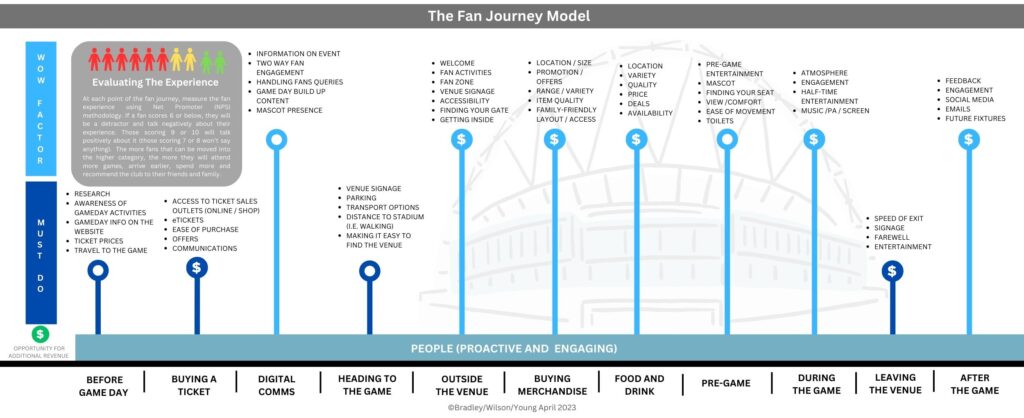The Fans Journey - Part 8: Food & Drink
Very often we hear the phrase that sport – but almost always football - is ‘a reflection of society’.
Admittedly, it’s usually after something bad has taken place. For example, if some kind of abuse is aimed at someone either at a game or online. We semi-explain it by trying to take it out of the context of football to demonstrate that the behaviours are merely those that can be found in society at large; and thus, why wouldn’t they also be seen at a game of football?
But if we wanted a much stronger example where sport (certainly not just football in this case and arguably a field where it is playing catch-up) reflects the wider world then it is surely when it comes to the food and drink we can now buy at stadiums.
Certainly, if we are looking for the biggest evolution in the fan experience, then it’s in this area in the last ten to fifteen years. The change has been breath-taking.
Sport, but football in particular, wasn’t exactly known for the quality of its food and drink at the best of times. When I first began to attend games in the early 1980’s, a steak and kidney pie and a cup of Bovril was about as good as it got (which to be fair was pretty good at the time but that’s not the point).

Mark Bradley
@fanexperienceco
Mark founded the Fan Experience Company in 2005 to build attendance growth and community engagement on the basis of improving fan experiences. He recently created FC Barcelona’s Barça Innovation Hub’s first fan engagement study certificate. The Fan Experience Company has undertaken more than 3,500 fan experience assessments in many countries for clients as diverse as The Danish Superliga, The EFL, The WSL / WC, United Rugby and Premiership Rugby.

Geoff Wilson
@fanexperienceco
Geoff runs his own Sports Consultancy, working with clients such as FIFA, UEFA, AFC and FIBA across the world. He is also on the board of Tourism Northern Ireland. You can follow Geoff on twitter @geoffwnjwilson connect on Linkedin at linkedin.com/in/geoffwnjwilson

Darren Young
@fanexperienceco
Darren joined the Fan Experience Company in 2017. He has an MBA with a background in customer service excellence having worked as a consultant in that field for a number of years. As well as being responsible for all of the assessment summary reports that are produced each season, he has also worked with a number of clubs on an individual basis, including Lincoln City, Walsall, Grimsby Town, Nottingham Forest and OH Leuven on projects ranging from staff development to supporter feedback surveys.
Even twenty years on, not much had changed and sometimes, a positive refreshments experience was defined by them not running out of hot food by half-time, and / or that you managed to spill no more than a quarter of your pint before the whistle went for the second half. But, on the whole, neither fans nor clubs cared too much for anything beyond the minimum you’d expect.
Contrast that to now, where some stadiums have areas (outside and occasionally inside too) with almost too much choice. And where product quality is evidently much more important than quantity. The cost too, it should be noted, is steeper than fans are accustomed too at stadiums, with prices for burgers – as an example - in line with those found in Christmas markets. But, again, that is merely a reflection of a wider society.
For if we look at city and town centres, and even the out-of-town establishments, they are awash with places with food and drink options that are a far cry from what we had come to expect in previous decades.
Fast food is still there, and never far away, but that is now the fall-back, rather than the only, option. Imaginative street food (from various continents), gourmet burgers, seafood cooked in just about every way imaginable and a food court can take you to pretty much any part of the world are now very much the norm.
Good food is important to people. For those making it, those eating it and those selling it.
The selection of drinks are no different. As well as stylish coffee and tea places that pride themselves on crafting hot beverages of the highest quality, there are many more soft drinks available and when it comes to alcohol, the choice is simply staggering. Gin bars are almost so 2017 by now, but they are just the tip of the ice-cube. The rise of popularity in tipples that once had no place in a sports stadium means they are now everywhere you look. Sport has joined in, and I’ve seen champagne bars in stadiums when I previously thought they only existed in the Westfield Shopping Centre.
The rapid emergence of the fan zone, especially in football, has helped to move refreshments to the next level, maybe even several levels. Once a rare nice-to-have, they are now almost a necessity for clubs, and this allows them to branch out with food and beverage items that are not traditionally sold inside or blocked altogether by catering contracts. The clubs that are learning to combine the outside fan zone with the inside – usually allowing fans to go to either or both during the game – are really winning here, offering their fans the best of both worlds, and making a lot more money by doing so.
To be fair to them, the sports of rugby and cricket have embraced the fan zone / food court combo for a while now. They have been slightly quicker – and better – at developing their grounds to be a part of the experience, a strategy that gets fans there much earlier and looks at the game as part of an event lasting for a significant period (a whole day in some forms of cricket). Football is fast catching on, but there is still a tendency to cram a lot into the fifteen minutes that separates each half. Fans don’t like to miss the action, where I’ve been to cricket and rugby games where the on-field play is secondary to the social and culinary aspect of the occasion. Who’s to say what is right and wrong? There is probably room for both, and we’ve also witnessed as fans - who have travelled 4,000 miles to Wembley to watch an NFL game - stand in the concourse eating a hot dog while watching the action on a small screen.
One common trend is the sense that if you build it, they will come. As fan zones are built, supporters quickly fill them, making you wonder why they took so long. The more bars and kiosks selling food and drink, the more it seems to be consumed. On a pre-pandemic trip to Aarhus in Denmark (a country that, I should add, prides itself on serving sausages of ridiculous lengths at its football grounds), we realised that when the club opened four or five times as many kiosks, the queues for them did not get shorter. A scenario of dreams rather than a field of them, it seems.
Which leaves us with Footy Scran, which possibly reflects the changing approach to food and drink at stadiums better than anyone or anything. Designed as a site where fans could post pictures of dodgy-looking items they had purchased – like a tongue-in-cheek name and shame with images – at football grounds around the world, it has morphed into one that highlights more of the good than the bad and the ugly.
As part of my research, I’m currently staring at a picture of a basket of coconut shrimp and truffle oil fries that is available at Atlanta United. The general response to it was very positive, although some fans thought it was a ‘bit too fancy’ for football.
Which probably tells you all you need to know about where we currently are.
But it’s hard to see it going in any direction other than ‘more fancy’. Because that’s just the kind of thing you see on the menus outside plenty of restaurants these days.
And sport is just a reflection of society, remember?


If you’d like help with this or other game day touch points, then make sure to listen in to The Fan Experience Experience podcast (on Spotify, Apple Podcasts and via Buzzsprout); to visit www.fanexperienceco.com or to email us via [email protected].
Mark Bradley, Geoff Wilson and Darren Young assessed the fan experience at eight matches at the 2022 World Cup in Qatar. Click here to read more about what they found there.